Words of Christopher de Chazal
Villa Sylvain has a very special place in the hearts of the Edgar de Chazal family (my Grandfather). This is the house (still standing) that his 13 children were brought up in. Tante Olga and Oncle André Robert lived in it far many years. Malcolm lived upstairs nearly all his life and my father (after divorce) lived next to Malcolm. Tante Emma (Kellman) lived out her life there.
Texte de Georges Robert (French and English)
Georges Robert (1939) < Olga de Chazal (1907) < Edgar de Chazal (1867) < Pierre Edmond de Chazal (1837) < Furcy de Chazal (1810) < Toussaint de Chazal (1770) < Régis de Chazal (1735) < Noble Aimé de Chazal (1706) < Jean-Naptiste Chazal (16..) < Jean II Chazal (16..) < Jean I Chazal (16..)
Villa Sylvain, Curepipe – Ile Maurice
Villa Sylvain a été une demeure familiale de 1908 à 1986. Mon grand père Edgar et ma grand mère Emma, sont arrivés dans la maison en 1908, maman avait 10 mois. Y sont nés mes oncles et tantes Cyril, Emma, Elsie, Louise, Charlie et Jimmy. Mon grand père, a transformé la maison avec sa famille qui s’agrandissait. L’ingénieur, M. Henri Genève, celui-la même qui a construit la Cathédrale St. Louis, a refait le toit en forme de mansarde et mes oncles et tantes y habitaient. Le toit contenait de belles essences.
La maison doit son nom “Villa Sylvain” à une anecdote familiale. Mon grand père aimait le nom Sylvain et voulait le donner à un de ses fils. Ma grand mère s’y est toujours opposée, si bien qu’il a donné le nom à la maison…
Ma grand mère, née Kellman, avait une sœur non mariée, Laura. Deux chambres ont été ajoutées pour elle et elle y a vécu la deuxième moitié de sa vie.
Au décès de mes grands parents en 1934 et 1935, la maison était occupée par ses enfants non mariés. Au mariage de ma mère, en 1938, elle et mon père se sont installés à Villa Sylvain, j’y suis né ainsi que ma sœur Pauline.
Je n’ai pas connu mes grands parents, mais j’ai passé mon enfance proche de tante Laura et de mes tantes et oncles non mariés qui habitaient la maison.
Mes parents sont devenus propriétaires de Villa Sylvain en 1948 mais la destination familiale de la maison a toujours été maintenue.
Tante Emma y a vécu jusqu’à ce qu’elle aille, dans les années 40, habiter chez ses amies Mazérieux, tante Louise jusqu’à son départ pour l’Afrique du Sud et oncle Charlie pour Madagascar. Oncle Malcolm a toujours gardé sa chambre dans la mansarde, il n’y était que pour les nuits, on le voyait lorsqu’il entrait et sortait. Il était très discret. Cependant on l’entendait marcher dans sa chambre la nuit lorsqu’il ne dormait pas. Ses journées se passaient, à une certaine période à l’hôtel National a Port Louis, puis au Morne. Oncle Cyril y a vécu dans les années 50 et 60, après sa séparation d’avec tante Mary, jusqu’à son départ pour l’Angleterre. La maison a aussi accueilli les enfants de tante Gladys. Dans les années 40-50, il n’y avait pas d’école proche des propriétés sucrières, les écoles se trouvaient à Curepipe. Villa Sylvain a donc connu les enfants de tante Gladys qui y venaient en pension. Oncle Dick a demandé que tante Gisèle y passe quelques temps avant la naissance de Françoise. Françoise est née à Villa Sylvain.
Cette destination familiale m’a gardé proche de la plus grande famille. Les oncles, tantes et cousins venaient rendre visite à tante Laura aux périodes de fêtes, Nol, le Nouvel An. C’est ma mère Olga qui gérait au mieux qu’elle pouvait ce va et vient familial.
Lorsque j’étais enfant il n’y avait pas d’invitations à des repas à Villa Sylvain. Les temps étaient difficiles. Par contre ma mère et mon père étaient toujours ouverts à tous visiteurs et l’hospitalité s’effectuait autour d’une tasse de thé. Il y en avait à toute heure. Le thé se servait souvent sous la véranda vitrée qui était le lieu de rencontre, et le solarium en hiver, elle se prêtait très bien aussi aux discussions peripateticiennes des divers membres de la famille qui échangeaient avec plus ou moins de passion leurs idées en l’arpentant d’un bout à l’autre. Les occupants de la maison autant que les visiteurs se rappellent aussi l’immense gravure qui a toujours été au mur de la salle à manger, une reproduction du tableau de Dignity and Impudence, un grand et un petit chien au repos devant leur niche.
La maison était entourée d’un grand jardin, à l’arrière duquel passait un cours d’eau, la Rivière Sèche, malgré le fait qu’il y avait toujours de l’eau… nous les enfants y faisions des pique niques sur ses bords, sous de grands et beaux arbres.. Ces arbres y avaient été plantés par mon grand père après un procès qu’il avait intenté aux Bois et Forets, et qu’il avaient gagné. Ce département gouvernemental s’opposait à cette initiative. Toutes les générations de cousins se souviennent très particulièrement d’un vieux jamalaquier, ils passaient de longs moments dans ses branches, et à la saison des fruits les degustaient accompagnés de sel.
Le jardin était aussi planté de superbes azalées blancs et roses, de camelias roses et blancs, de magnifiques bougainvilleas rouges, une glycine, des rosiers rouges “Crimson Glory” aussi beaux que parfumés, des hortensias bleus. Ma grand mère aimait beaucoup le jardin et elle s’y est beaucoup interessée. Après elle c’est tante Louise qui s’en est occupée, avant que ma mère ne prenne la relève après le départ de tante Louise. Ma mère a géré les acquis, et en souvenir de sa maman, qui aimait les fleurs mauves, a privilégié les delphiniums bleus et blancs, et les violettes mauves.
D’autres souvenirs sont attachés à ceux qui ont vécu proches de Villa Sylvain. Mes grands parents avaient une bonne, Adrienne, que j’ai connue quand elle était agée. C’était une Malagasy très distinguée. Elle était très attachée à mes grands parents et réciproquement, elle n’était pas mariée, habitait la dépendance avec sa soeur Laure, qui était la bonne d’Oncle Malcolm, et son frère Léon. Elle était très pieuse. Je garde d’elle le souvenir d’une aristocrate.
Ma sœur Pauline a fait construire sa maison dans le jardin arrière dans les années 1960. Elle est partie pour l’Australie en 1986, et mes parents, qui se trouvaient alors seuls et vieillissant, sont venus chez nous à Eau Coulée où une maison y a été construite pour eux. En 1986 la maison a été vendue et abrite une école maternelle.
ENGLISH VERSION ( Translation Christopher de Chazal)
From Georges Robert
Georges Robert (1939) < Olga de Chazal (1907) < Edgar de Chazal (1867) < Pierre Edmond de Chazal (1837) < Furcy de Chazal (1810) < Toussaint de Chazal (1770) < Régis de Chazal (1735) < Noble Aimé de Chazal (1706) < Jean-Naptiste Chazal (16..) < Jean II Chazal (16..) < Jean I Chazal (16..)
Villa Sylvain, Curepipe – Ile Maurice
Villa Sylvain was a family home from 1908 to 1986. My Grandfather and Grandmother Emma, took it over in 1909 when my mother was 10 years old. It was there that my uncles and aunts, Cyril, Emma, Elsie, Louise, Charlie and Jimmy were born. My Grandfather transformed the house as his family grew. The Engineer. M. Henri Genève, the same who built St Louis Cathedral in Port louis, oversaw the construction of the mansard roof where my uncles and aunts lived. The roof smelt of wood essences.
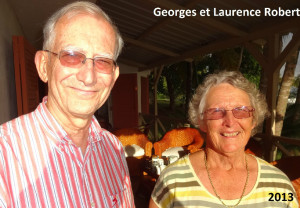
There is a family anecdote concerning the house being named “Villa Sylvain”. My Grandfather wished to call one of his sons « Sylvain » as he liked the name. My Grandmother was always against it, so much so that she gave the name to the house instead.
My grandmother whose maiden name was « Kellman », had an unmarried sister, Laura. Two rooms were added to accomodate her and she lived threre for the latter years of her life.
At the death of my Grandparents in 1934 and 1935, the house was occupied by the unmarried children. On my mother’s marriage, in 1938, she and my father settled in Villa Syvain, I was born there as was my sister Pauline.
I never knew my Grandparents, but spent my childhood close to my Great Aunt Laura and my unmarried uncles and aunts who lived in the house.
My parents became owners of Villa Sylvain in 1948; nevertheless it maintained its position as a focus for the family.
Tante Emma lived there until she went, in the 1940s, to live with her friends the Mazérieux family, Tante Lousie until her departure for South Africa and Uncle Charlie for Madagascar. Uncle Malcolm kept his room in the mansard roof, where he stayed only during the night, we only saw him comming and going. He was very discreet and therefore we only heard him pacing the floor at night when he could not sleep. His days were spent, at one point in his life, at The National Hotel in Port Louis, then at Le Morne. Uncle Cyril lived there in the 50s and 60s after his separation from Aunt Mary and before his depature for Europe. The house also welcomed Tante Glady’s children. In the 40s and 50s there was no suitable school near the sugar estates, the better schools were situated in Curepipe. Villa Sylvain therefore became their boarding home during term time. Uncle Dick requested that Tante Gisèle should stay there for a while before the birth of Françoise. Françoise was born in Villa Sylvain.
The Family home kept me close to the wider family circle. All the uncles, aunts and cousins came to visit Great Aunt Laura on high-days and holidays, Christmas and New Year. As best she could, it was my mother who fostered these family comings and goings.
When I was young there were no invitations to meals at Villa Sylvain. Times were difficult. On the other hand my Mother and Father held open house and hospitality was centred over a cup of tea which was always available. Tea was often served on the glassed-in varandah which was used as a meeting place and, in winter. served as a solarium; it lent itself also very well to peripathetique discussion as different members of the family could parade up and down exchanging ideas with more or less passion, The inhabitants, as well as those visiting, well remember the large picture which always hung on the dining room wall, a reproduction of the painting ‘Dignity and Impudence’, a large hound and small dog in front of their shared kennel.
The house was surrounded by a large garden behind which there was a river named Dry River (Riviere Seche), despite the fact that it always had flowing water. As children we had picnics on its banks, under the fine trees. These trees had been planted by my Grandfather after a court case that he brought, and won, against the Department of Woods and Forests. This Government Department was opposed to his initiative. Generations of cousins particulaly remember an old jamalaquier, they spent many hours in its branches and in season ate its fruit seasoned with salt.
The garden was planted with superb white and red azaleas, red and white camelias, magnificent red bougainvileas, a glycine, red roses « Crimson Glory » as colourful as they were perfumed, and blue hydrangeas. My Grandmother loved her garden and took a lot of interst in it. After her it was tante Louise who looked after it, before my mother took it over when Tante Louise left. My mother treasured that which she had been left in memory of her mother who loved mauve flowers. My mother gave preference to blue and white delphinium as well as purple violets.
Other memories are of those close to Villa Sylvain. My grandparents had a maid Adrienne, whom I knew in her old age. She was a noble Malgasy. She was very fond of my Grandparents and they of her, she was unmarried, lived in the servants quarters with her sister Laure, who was Uncle Malcolm’s maid, and their brother Léon. She was religious and I remember her as being very aristocratic in her demeanor.
My sister Pauline had a house built in the back garden in the 1960’s. She emigrated to Australia in 1986 and my parents, who found themselves alone in their old age, came to live with us in Eau Coulée where a house was built for them. In 1986 Villa Syvain was sold and is now a nursery.
Translator’s notes:
Villa Sylvain is situated on the southern slope of the Trou aux Cerf in The Rue Bernardin de St Pierre, Curepipe. I lived opposite Villa Syvain for three years in the early 50s. The house is not large and it is difficult to think how 13 children were brought up there.
Georges is writing about the years during, and soon after the Second World War. Very little could be imported as all available shipping was provisioning Europe. Those days of austerity are difficult to understand now that we live in a period of plenty. Mauritius was a backwater deserving of little consideration. We had one ‘plane per week which brought the airmail post from Europe. Fuel was imported in four gallon tins. Meat inported from Madagascar consisted of bullocks unceremoniously cast into the water and made to swim ashore—the meat was tough as old boots. I remember a new toothbrush to be a real excitement.
Glycine—the plant—is a type of bean and in this case I think a creeper. I remember the large daliahs of many colours. The back garden produced vegetables for the table
Jamalaque, an attractive bell like fruit, crisp with little flavour is shown in the photograph.
The monochrome photo of Villa Sylvain must have been taken before 1953 because it shows the drive of broken stone. Uncle André bought a small rear engine Renault and had the drive tarred over. I remember riding on the steam roller. Weeds grew in the broken stone; the Bibi (lady gardener) weeded it with a bent knife.
The house is now much as it used to be but I think it has a black roof. My recollection is that the roof was blue; the picture shows it red.
My translation has deliberately kept and mixed the title oncle/uncle and tante/aunt. As a mark of respect all relatives were given their title at every opportunity. I deplore the lack of respect these days.
Text of Christopher de Chazal (English version)
Christopher de Chazal (1939) < Cyril de Chazal (1909) < Edgar de
Chazal (1867) < Pierre Edmond de Chazal (1837) < Furcy de Chazal (1810) < Toussaint de Chazal (1770) < Régis de Chazal (1735) < Noble Aimé de Chazal (1706) < Jean-Naptiste Chazal (16..) < Jean II Chazal (16..) < Jean I Chazal (16..)
Opposite us in rue Bernardin de Saint Pierre lived Oncle André and Tante Olga, my father’s sister, and their two children Georges and Pauline. Georges was important to me and we will be discussing him further. Tante Laura (Kellman) lived in an annex to their home. Oncle Malcolm lived in one of the two rooms set in the mansard roof.
In the dependence lived Adrienne and Laure, who had been with the family for ages. They were retainers really and did little real work for Tante Olga
Their house is named “Villa Sylvain”. This house has a very special place in the annals of The de Chazal family and therefore needs some more description.
Villa Sylvain: Basically a single story house with mansard roof in which was a large room divided into two. It was about three rooms deep with a glassed-in veranda. The kitchen was at the back and if I remember correctly was quite narrow. Outside the kitchen door was a huge Jamalque tree, well shaped for climbing and giving a lot of fruit every year. We used to take some salt and sit in the tree enjoying the crisp pink fruit which may be called rose apple or tambis.
The centre of the house consisted of a little used living room, through which one walked to get to the front door, at the rear was the dining room. This contained a barometer which Tante Laura would consult daily and at times of interesting weather patterns she would look at every half hour if the need arose. Above the sideboard was a large picture of two dogs at a kennel—it is a well known picture, black and white I think, also a silver mounted mirror.
To the left was Oncle Andre’s study. This is where he was mostly to be found, he loved his work and had a successful and respected business as Attorney-at-Law. Behind that was George’s room. There was a bathroom down some stairs, the levels being lower. To the right of the living rooms was the main bedroom and probably that of Pauline.
Their telephone number was 224.
When I think of it like this I wonder how our grandparents with thirteen children managed, they must have been very much on top of each other.
The back garden was large with a stone wall down the middle. I think it produced quite a lot of produce. The volcanic earth was fertile, rainfall prolific and warm temperatures fairly steady. The river was the back boundary but the land there was very wet so was left as a patch of grass surrounded by tall trees. Much later Pauline had a house built there or maybe it was further towards the main house.
The front garden had some magnificent giant dahlias at the right time of year.
Behind the garage which was at the back of the dependence was a bed in which manioc grew.
The river was beautiful, very wild. Goave de Chine (small guavas) bushes grew there. When the sun shone there would be dappled sunshine coming through the trees, small birds and butterflies fluttered along the river which was not controlled in any way and hence rose and fell quickly. One could catch “pic-pics” by putting some chewing-gum on a stick, when they perched there they got stuck. I don’t think we did this much, in fact we rarely went down to the river at all.
Wasp’s nests could be seen in trees and we would smoke them out and throw stones to get them down. The best antidote to a sting is to pee on the spot where it hurts. The reason for all this is to obtain the grubs and eat them fried. It is all very well eating exotic things but when one has undergone real danger from fire, danger from stings, danger from stones flying about and the excitement of being The Big Hunter, then the reward of the food is extra special.
Tante Olga had an oven. This was a paraffin heater with a metal box on the top; I think I was there when it was delivered, we were thrilled! It was quite effective I think. Previously everything had been done on charcoal.
.
She had a nénene to care for the children and do the chores, I think there was a male gardener but I also remember a “bibi” weeding the drive, she was probably casual labour. Surely there was a cook but I do not remember her.
Hawkers would come round with large baskets on their head selling bread, vegetables and live chicken. The main bread was a “ti-di-pain” which was a good sized roll; they were always fresh and delicious. A spiced roll was called “mucacha” (muck-ah-cha). In the evening a man on a bicycle went round the streets selling flat pancake type food (dall-pouri) with different savoury spreads.
I think most of the food buying was done by the servants.
I don’t remember how Oncle André got to work, he must have had a car and I do remember they had a small Renault with the engine at the rear, after that I think they had a Triumph, the one with sharp edges making it box-like. The drive was made of stones about 2 inches across which caused dust, weeds and was generally untidy. One day this was made smooth by tar, a steam roller came for the day and we could ride on it. A real proper steam roller—that was something to remember.
Oncle André was married to Tante Olga: Oncle André was an attorney-at-law, a Mauritian though and through. He worked very long hours and was very well respected. I do not think I ever got to know him, he was just another adult. He had high standards. I do not think he was a socialite but he enjoyed company, more specially if it was to do with his work.
It is only now that I realise that he took over my grandfather’s business in Port Louis. He was the obvious candidate to so.
It was at Christmas time that I got to realise that he was much liked. It was then that Adrienne and Laure came into their own. Oncle André was showered with gifts from grateful clients, the Chinese were especially generous. They gave uncooked hams. Adrienne and Laure would build a fire in their front yard fuelled with wood. The “pot” would be a four-gallon petrol tin and the ham was boiled for many hours. In an Island with little meat this was a real luxury.
Adrienne was quite tall and held herself well. I remember they had peach trees in their yard and they brushed their teeth with peach twigs, hey had good white teeth.
Oncle André I think left parenting to Tante Olga and the nénene however he took a great interest in their education and Georges benefited much from his encouragement, advice and example.
I last saw Oncle André in 1990. When we arrived he was sitting at his desk, in the same way as I always remembered him, nothing had changed. It was sad time because Tante Olga was very ill and in fact she died some days after.
Tante Olga: had been brought up in Villa Sylvain. She was quite laid back and took things in her stride. She ran the household, was very generous with her time and was pleased to see anyone who came.
When Tante Olga died we were in Mauritius with several of my first cousins. I was invited with some of them to be a pall-bearer. I was touched by this honour. The big church in Curepipe (St Therese) was full, with standing room only, the Prime Minister was there—no doubt because of Oncle André;s reputation. Fortunately we did not have to carry the coffin, it was put on a trolley which we wheeled in, head towards the alter. I am still to this day concerned that when we wheeled the coffin out poor Tante Olga went head first. I think she should have been turned around. Was there space? Did we get it wrong? Was there a lack of communication between us? Odd, the things we worry about.
Georges was born six months and one day after me. I think it is this fact that reminds me each year to celebrate my half-birthday; thank you Georges. Because he lived across the road from me, spoke excellent English, and was my age, we were friends. We were of course completely different.
Georges had had a stable background with his mother always present at home. He had cousins and friends since childhood and knew no other life than that at school and at home. As a contrast my life had been disrupted at the age of six, I had lived in Europe, changed language and school several times, I don’t think I was aware of it as a fact but I probably felt that my parents were not getting on as they should. I did not settle at school and was, I think, not happy.
I should have followed Georges’ good example, he was serious, studious and an all round good-guy, I just did not have his make-up.
I was not inclined to music or sport. I can’t think of anything I had any aptitude for and cannot think that I made any effort to be pleasant, nevertheless Tante Olga and Georges seemed quite happy to see me. I will always be grateful to them for that.
I remember playing with a football in their front garden, a small area. The bamboo hedge was thick enough that the ball would rebound off it, this was my speciality and I would run round Georges to score (will he dare to contradict me?). We had endless games of mah-jong and monopoly sitting in their veranda. Georges rarely came over to our place.
Kassim had our meal ready at 19.00 every evening promptly after which he went home. He probably used the charcoal to start up the wood stove to give hot water for the bath.
Georges went on to win scholarships to The Royal College and then “The Big One” to go to Oxford to study law. While there he came from time to time to 28 St Gabriels. Georges would always go back to be a big fish in a relatively small pond but he was expected to go back to help his father. Georges was very faithful to his father but my opinion is that left to his own devices he would have modernised, expanded and done a lot of things. The trouble was that Oncle André dominated their working life and Georges had his own son André join the business before he really had the chance. By then of course the inclination was lacking. Georges will give advice if asked but I think that he has now given André Jnr carte blanche to do as he sees fit with the business.
Where Georges met Laurence and how he managed to get her to marry him is a mystery known only to themselves. It may well have been through the church, Roman Catholicism and a spiritual life is important to them. Laurence is a real gem, a wonderful wife, mother, organiser, cook, manager, secretary, confident. Georges knows. They have three talented children; André Jnr who took over the law business, Anne who has emigrated to Montreal with her daughter Emma, and Patrice. Patrice studied at Southampton University and visited us in Guildford from time to time. I remember in his first weeks some friends and I went down there to run The Great South Run. Patrice ran also, Laurence came to support us all. Patrice spent some years in Singapore working for a US courier firm, DHL. He is now CEO of a Mauritian firm dealing in fish products. I am sure the present 2008 credit crunch will impinge on his business which turns over £millions.


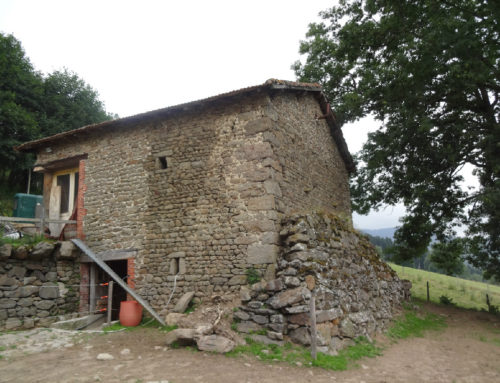
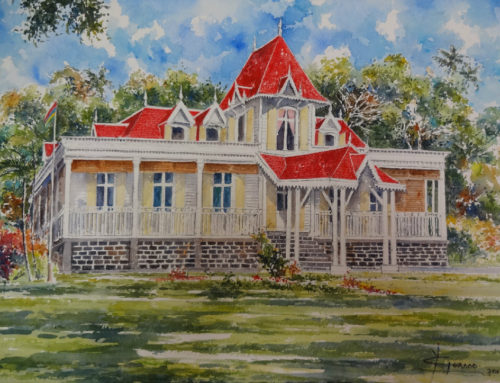
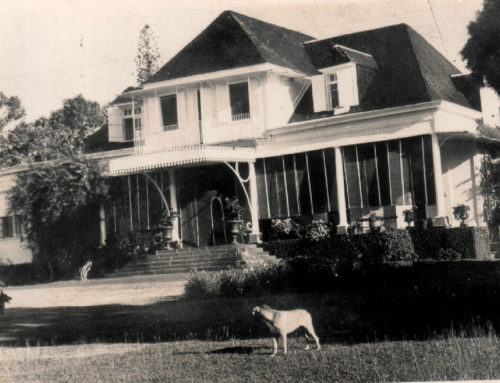

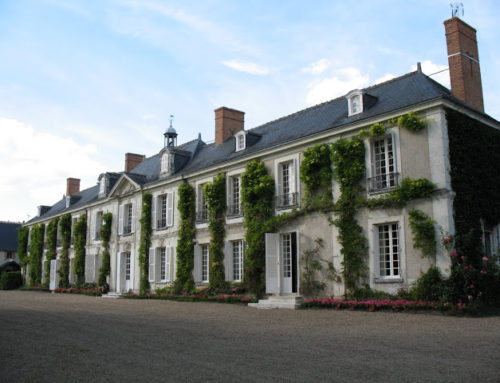
Leave A Comment
You must be logged in to post a comment.